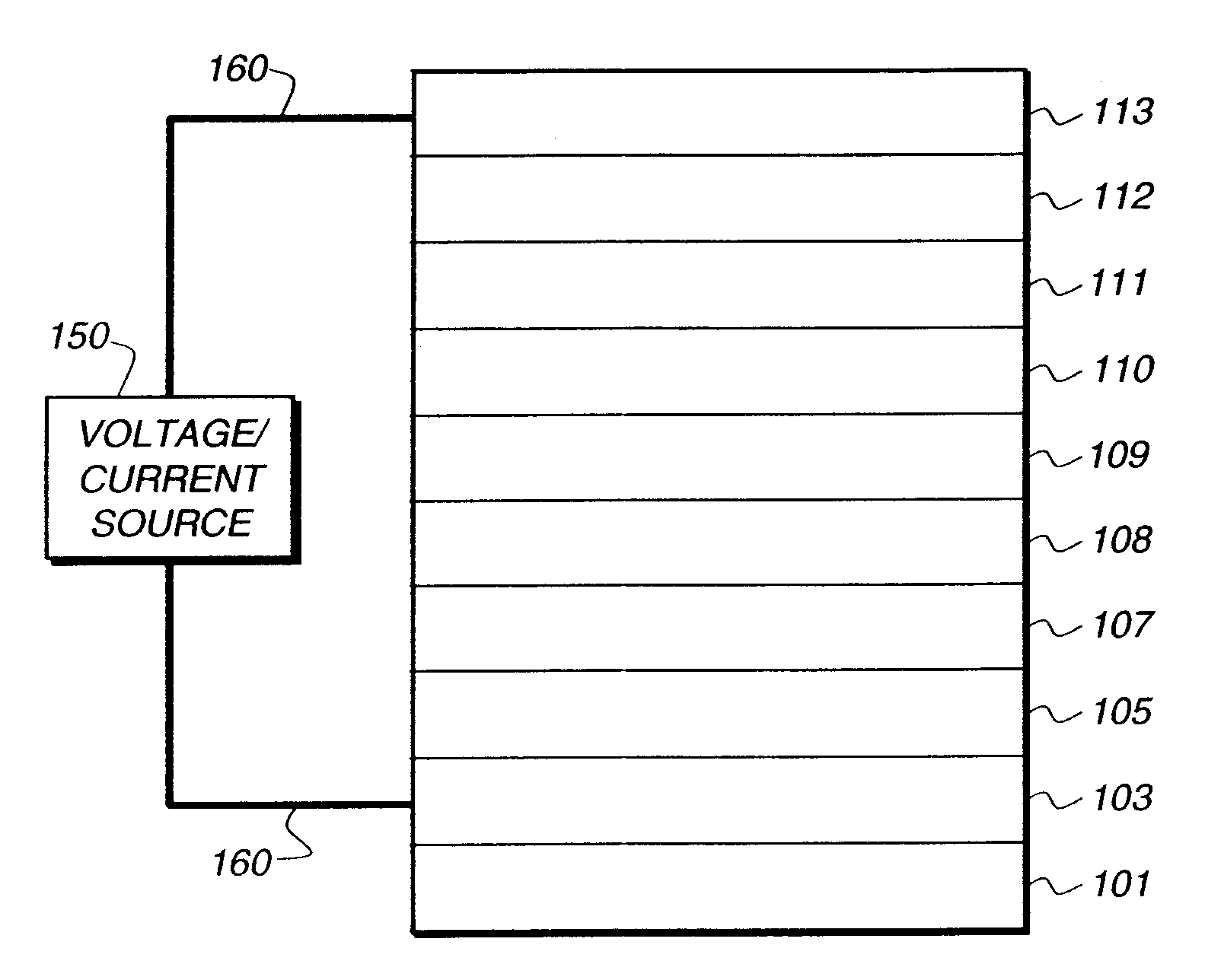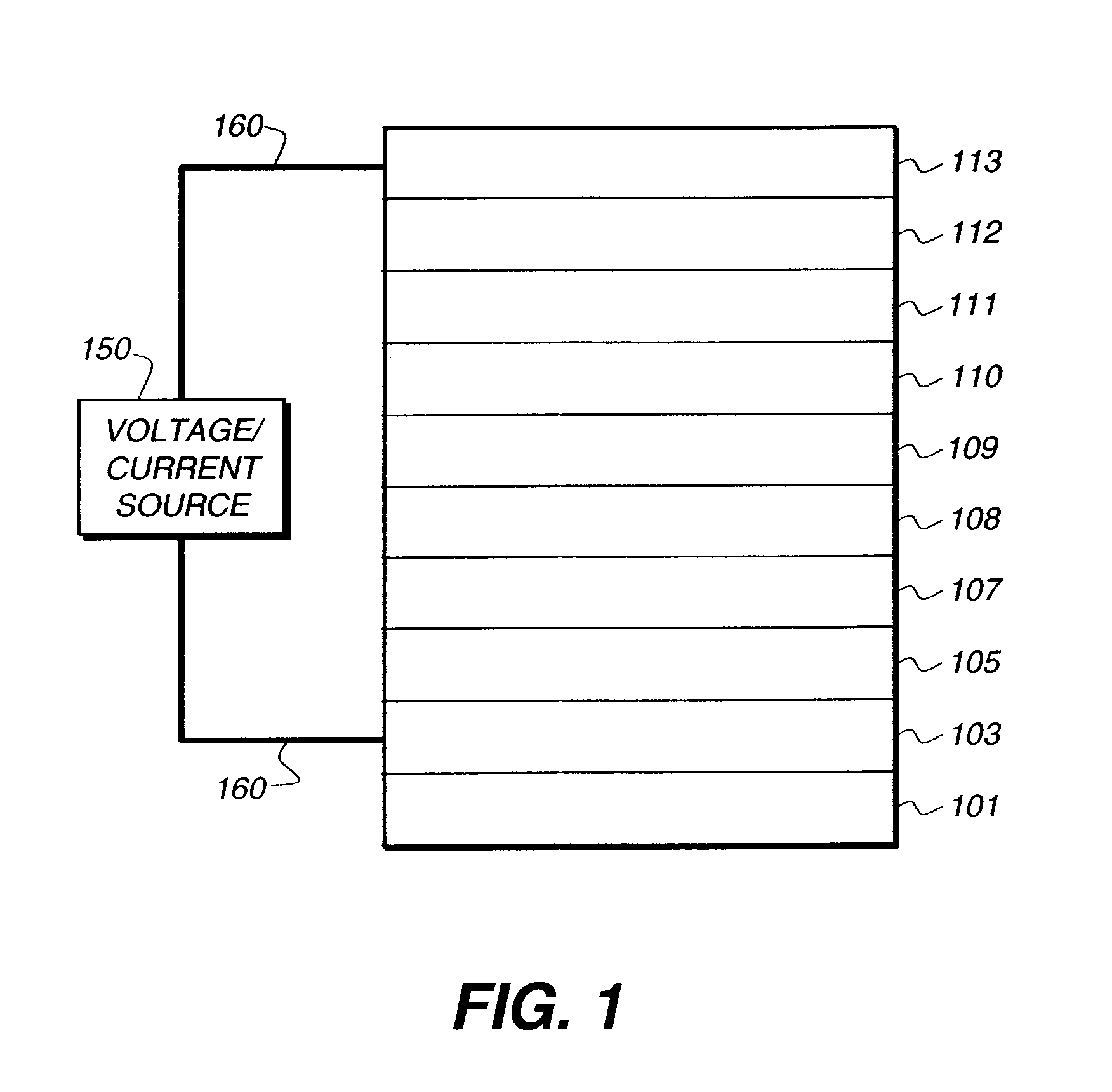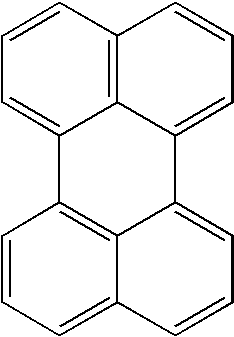Hybrid fluorescent/phosphorescent oleds
a light-emitting diode and hybrid technology, applied in the direction of discharge tube/lamp details, discharge tube luminescnet screens, lamp details, etc., can solve the problems of large loss of efficiency, excitons created, and performance limitations that have been a barrier to many desirable applications, and achieve the effect of improving efficiency
- Summary
- Abstract
- Description
- Claims
- Application Information
AI Technical Summary
Benefits of technology
Problems solved by technology
Method used
Image
Examples
examples 1-1 to 1-4
[0381]An EL device (Device 1-1) satisfying the requirements of the invention was constructed in the following manner:[0382]1. A glass substrate, coated with an approximately 25 nm layer of indium-tin oxide (ITO) as the anode, was sequentially ultrasonicated in a commercial detergent, rinsed in deionized water and exposed to an oxygen plasma for about 1 minute.[0383]2. Next, a hole transporting layer (HTL) of N,N′-di-1-naphthyl-N,N′-diphenyl-4,4′-diaminobiphenyl (Host-7 or NPB) was vacuum deposited to a thickness of 75 nm.[0384]3. An exciton / electron blocking layer (EBL) of 4,4′,4″-tris(carbazolyl)-triphenylamine (Host-6 or TCTA) was vacuum deposited to a thickness of 10 nm.[0385]4. A 5 nm light emitting layer (LEL1) consisting of a mixture of Host-8 as the host, and Emitter-1 as a blue fluorescent emitter present at concentration of 1 wt. % relative to the host was then vacuum deposited onto the exciton blocking layer.[0386]5. A spacer layer of undoped Host-2 having a thickness of 5...
examples 2-1 to 2-5
[0394]An EL device (Device 2-1) satisfying the requirements of the invention was constructed in the same manner as devices 1-1 to 1-4 with the following components: ITO / NPB (75 nm) / TCTA (10 nm) / Host-8+1% Emitter-1 (5 nm) / Host-13 (10 nm) / Host-13+8% Ir(ppy)3 (20 nm) / Bphen (25 nm) / LiF:Al
[0395]This device showed the emission from both the blue fluorescent dopant and the green phosphorescent Ir(ppy)3 dopant. At 1 mA / cm2, the luminance yield was 39.2 cd / A with CIE (x,y) of (0.232, 0.425) for an external quantum efficiency of 14.2%. The luminous yield and EQE were still higher at lower current densities. It should be noted that Host-13 (the spacer material and the phosphorescent host) has a triplet energy of 2.57 eV compared to Host-8 (2.67).
[0396]EL devices not satisfying the requirements of the invention were constructed in same manner as 2-1 except the blue fluorescent emitter was Emitter-2. The concentration was 1% in 2-2, 2% in 2-3, 5% in 2-4, and 7.5% in 2-5. Comparative example 2-2 ...
example 3-1
[0397]An EL device (Device 3-1) satisfying the requirements of the invention was constructed in the same manner as devices 1-1 to 1-4 with the following components: ITO / NPB (75 nm) / TCTA (10 nm) / Host-22+1% Emitter-1 (5 nm) / Host-13 (10 nm) / Host-13+8% Ir(ppy)3 (20 nm) / Bphen (20 nm) / LiF:Al
[0398]This device showed the emission from both the blue fluorescent dopant and the green (Ir(ppy)3) phosphorescent dopant. At 1 mA / cm2, the luminance yield was 33.2 cd / A with CIE (x,y) of (0.220, 0.380) for an external quantum efficiency of 13%. The luminous yield and EQE were still higher at lower current densities. The fluorescent host in this device has a HOMO of −5.59 eV and a triplet energy of 2.76 relative to the fluorescent emitter with a HOMO of −5.69 and the spacer material and phosphorescent host with a triplet energy of 2.57.
PUM
 Login to View More
Login to View More Abstract
Description
Claims
Application Information
 Login to View More
Login to View More - R&D
- Intellectual Property
- Life Sciences
- Materials
- Tech Scout
- Unparalleled Data Quality
- Higher Quality Content
- 60% Fewer Hallucinations
Browse by: Latest US Patents, China's latest patents, Technical Efficacy Thesaurus, Application Domain, Technology Topic, Popular Technical Reports.
© 2025 PatSnap. All rights reserved.Legal|Privacy policy|Modern Slavery Act Transparency Statement|Sitemap|About US| Contact US: help@patsnap.com



